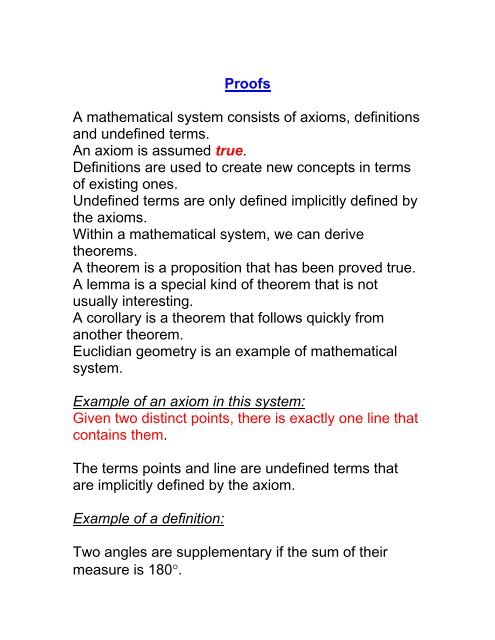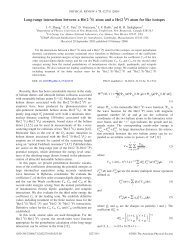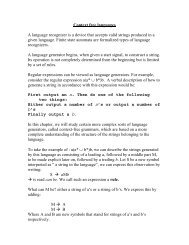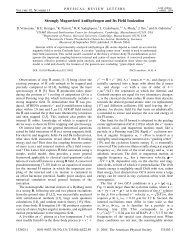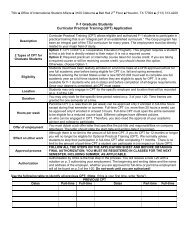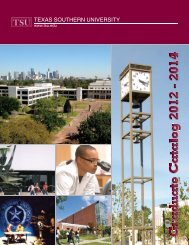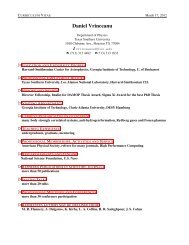Proofs A mathematical system consists of axioms, definitions and ...
Proofs A mathematical system consists of axioms, definitions and ...
Proofs A mathematical system consists of axioms, definitions and ...
Create successful ePaper yourself
Turn your PDF publications into a flip-book with our unique Google optimized e-Paper software.
<strong>Pro<strong>of</strong>s</strong><br />
A <strong>mathematical</strong> <strong>system</strong> <strong>consists</strong> <strong>of</strong> <strong>axioms</strong>, <strong>definitions</strong><br />
<strong>and</strong> undefined terms.<br />
An axiom is assumed true.<br />
Definitions are used to create new concepts in terms<br />
<strong>of</strong> existing ones.<br />
Undefined terms are only defined implicitly defined by<br />
the <strong>axioms</strong>.<br />
Within a <strong>mathematical</strong> <strong>system</strong>, we can derive<br />
theorems.<br />
A theorem is a proposition that has been proved true.<br />
A lemma is a special kind <strong>of</strong> theorem that is not<br />
usually interesting.<br />
A corollary is a theorem that follows quickly from<br />
another theorem.<br />
Euclidian geometry is an example <strong>of</strong> <strong>mathematical</strong><br />
<strong>system</strong>.<br />
Example <strong>of</strong> an axiom in this <strong>system</strong>:<br />
Given two distinct points, there is exactly one line that<br />
contains them.<br />
The terms points <strong>and</strong> line are undefined terms that<br />
are implicitly defined by the axiom.<br />
Example <strong>of</strong> a definition:<br />
Two angles are supplementary if the sum <strong>of</strong> their<br />
measure is 180°.
If two sides <strong>of</strong> a triangle are equal, then the angles<br />
opposite them are equal.<br />
A corollary is:<br />
“If a triangle is equilateral, then it is equiangular.”<br />
Theorems are <strong>of</strong>ten <strong>of</strong> the form:<br />
Theorem 1:<br />
for all x 1 , x 2 ,…, x n , if p(x 1 , x 2 ,…, x n ) then q(x 1 , x 2 ,…, x n )<br />
This universally quantified statement is true provided<br />
that the conditional statement:<br />
if p(x 1 , x 2 ,…, x n ) then q(x 1 , x 2 ,…, x n )<br />
is true for all x 1 , x 2 ,…, x n.<br />
Direct pro<strong>of</strong>:<br />
To prove that Theorem 1 is true, we assume that:<br />
1. x 1 , x 2 ,…, x n are arbitrary members <strong>of</strong> the domain<br />
<strong>of</strong> discourse.<br />
2. We also assume that p(x 1 , x 2 ,…, x n ) is true<br />
3. then , using p(x 1 , x 2 ,…, x n ) as well as other<br />
<strong>axioms</strong>, <strong>definitions</strong> <strong>and</strong> previously derived<br />
theorems, we show directly that q(x 1 , x 2 ,…, x n ) is<br />
true
We will give a direct pro<strong>of</strong> for the following statement:<br />
For all real numbers d, d 1 , d 2 , <strong>and</strong> x<br />
If d = min {d 1 , d 2 } <strong>and</strong> x ≤ d then x ≤ d 1 <strong>and</strong> x ≤ d 2<br />
Pro<strong>of</strong>:<br />
We will assume that d, d 1 , d 2 <strong>and</strong> x are arbitrary real<br />
numbers.<br />
We will assume that<br />
{d = min {d 1 , d 2 } <strong>and</strong> x ≤ d }is true <strong>and</strong> then prove that<br />
: x ≤ d 1 <strong>and</strong> x ≤ d 2<br />
From the definition <strong>of</strong> a minimum, it follows that :<br />
d ≤ d 1<br />
<strong>and</strong><br />
d ≤ d 2<br />
From x ≤ d <strong>and</strong> d ≤ d 1 , we derive that x ≤ d 1<br />
From x ≤ d <strong>and</strong> d ≤ d 2 , we derive that x ≤ d 2,<br />
Therefore, x ≤ d 1 <strong>and</strong> x ≤ d 2
Indirect Pro<strong>of</strong>:<br />
Since the implication p q is equivalent to its<br />
contrapositive ¬q¬p , the implication p q can be<br />
shown by proving its contrapositive ¬q¬p is true.<br />
Prove that<br />
For all real number x <strong>and</strong> y, if x+y ≥ 2, then either x≥ 1<br />
or y ≥ 1.<br />
Pro<strong>of</strong>:<br />
Suppose that:<br />
We assume the conclusion is false:<br />
either x≥ 1 or y ≥ 1 is false<br />
So, its negation : ¬ (either x≥ 1 or y ≥ 1) is True,<br />
And should conclude that the hypothesis is false<br />
: x+y ≥ 2 is false<br />
¬ (either x≥ 1 or y ≥ 1) is True ⇔ x
For all real number x <strong>and</strong> y, if x+y ≥ 2,<br />
then either x≥ 1 or y ≥ 1 is true.<br />
This special case <strong>of</strong> pro<strong>of</strong> is called a pro<strong>of</strong> by<br />
contrapositive.<br />
Deductive reasoning:<br />
The process <strong>of</strong> drawing a conclusion from a sequence<br />
<strong>of</strong> propositions is called deductive reasoning.<br />
For example:<br />
1. The bug is either in module 17 or in module 81.<br />
2. The bug is a numerical error<br />
3. Module 81 has no numerical error.<br />
If these statements are true, it is reasonable to<br />
conclude that<br />
The bug is in module 17.<br />
The given propositions are called hypotheses, <strong>and</strong> the<br />
proposition that follows from the hypotheses is called<br />
conclusion<br />
Valid argument:<br />
Any argument <strong>of</strong> the form<br />
If p 1 <strong>and</strong> p 2 <strong>and</strong> …p n then q can be written as a<br />
sequence <strong>of</strong> propositions:
p 1<br />
p 2<br />
.<br />
.<br />
p n<br />
∴ q<br />
The propositions p 1 p 2 …p n are called the premises<br />
or the hypotheses <strong>and</strong> q is called the conclusion.<br />
The argument is valid provided that:<br />
if p 1 <strong>and</strong> p 2 … <strong>and</strong> p n are all true, then q must also be<br />
true .Otherwise, the argument is invalid or a fallacy.<br />
Determine whether<br />
p q<br />
p<br />
is valid<br />
∴q<br />
Pro<strong>of</strong> :<br />
Suppose that p q <strong>and</strong> p is true. Then q must be<br />
true, otherwise p q would be false.<br />
Therefore, the argument is valid.<br />
Rules <strong>of</strong> inference for propositions:<br />
For a pro<strong>of</strong> as a whole to be valid, each step <strong>of</strong> the<br />
pro<strong>of</strong> has to draw intermediary conclusions that are<br />
valid.
To make sure that the intermediary conclusions are<br />
valid, each conclusion has to be deduced using some<br />
<strong>of</strong> the rules <strong>of</strong> inference listed below:<br />
Rule <strong>of</strong> inference<br />
p q<br />
p<br />
∴ q<br />
p q<br />
¬q<br />
∴ ¬p<br />
p<br />
∴ p ∨ q<br />
p ∧ q<br />
∴ p<br />
p<br />
q<br />
∴ p ∧ q<br />
p q<br />
qr<br />
_________<br />
∴ p r<br />
Name<br />
Modus Ponens<br />
Modus Tollens<br />
Addition<br />
Simplification<br />
Conjunction<br />
Hypothetical syllogism
p ∨ q<br />
¬p<br />
∴ q<br />
Disjunctive syllogism<br />
Which rule <strong>of</strong> inference is used in the following<br />
argument:<br />
If the computer has 32 Meg <strong>of</strong> RAM, then it can run<br />
“SoundBlaster”, if it can run “SoundBlaster” then the<br />
sonics will be impressive.<br />
Therefore, if the computer has 32 Meg then the<br />
sonics will be impressive.<br />
P : “The computer has 32 meg <strong>of</strong> RAM”<br />
Q : “The computer can run “SoundBlaster””<br />
R : “The sonics will be impressive”<br />
The arguments can be represented as:<br />
P Q<br />
Q R<br />
∴P R<br />
This argument uses the hypothetical syllogism rule,<br />
so it is true.<br />
Let’s have the following argument:
if I study hard, then I get A’s<br />
I study hard.<br />
Let p: “I study hard”, q: I get A’s<br />
If I study hard then I get A’s<br />
I study hard<br />
_______________________________<br />
∴ I get A’s<br />
p q<br />
p<br />
_________<br />
∴ q<br />
This argument uses the modus ponens, therefore it is<br />
valid.<br />
Let’s have the argument:<br />
If I study hard, then I get A’s,<br />
I do not get A’s, therefore I do not study hard.<br />
p q<br />
¬q<br />
_________<br />
∴ ¬p<br />
This argument uses the modus tollens, therefore it is<br />
valid.<br />
Let’s have the argument:
I study hard, therefore I study hard or I will get rich<br />
p<br />
_________<br />
∴p ∨ q<br />
This argument uses the addition rule <strong>of</strong> inference,<br />
therefore it is valid.<br />
Let’s have the argument:<br />
I study hard <strong>and</strong> I get A’s, therefore I study hard<br />
p∧q<br />
________<br />
∴p<br />
This argument uses the simplification rule <strong>of</strong><br />
inference, therefore it is valid<br />
Let’s have the argument:<br />
I study hard, I have A’s, therefore I study hard <strong>and</strong> I<br />
have A’s<br />
p<br />
q<br />
______<br />
∴ p ∧ q
This argument uses the conjunction rule <strong>of</strong> inference<br />
therefore it is valid<br />
Let’s have the argument:<br />
I study hard or I get A’s, I do not get A’s, therefore I<br />
study hard<br />
p ∨ q<br />
¬ q<br />
----------<br />
∴ p<br />
This argument uses the disjunctive syllogism rule <strong>of</strong><br />
inference therefore it is valid<br />
Rules <strong>of</strong> Inference for Quantified Statements:<br />
There are 4 rules <strong>of</strong> inference for quantified<br />
statements:<br />
Let x be a universally quantified variable in the<br />
domain <strong>of</strong> discourse D, such that p(x) is true,<br />
∀ x∈ D, p(x) is true
Rule <strong>of</strong> Inference<br />
∀ x∈ D P(x)<br />
-------------------<br />
∴ P(d) if d ∈ D<br />
P(d) for any d ∈ D<br />
--------------------------<br />
∀ x∈ D P(x)<br />
∃ x∈ D P(x)<br />
-------------------<br />
∴ P(d) for some d ∈ D<br />
P(d) for some d ∈ D<br />
--------------------------<br />
∃ x∈ D P(x)<br />
Name<br />
Universal instantiation<br />
Universal generalization<br />
Existential instantiation<br />
Existential generalization<br />
Everyone who is taking CS124 wants an A.<br />
Let’s D be the domain <strong>of</strong> all students taking CS124<br />
P(x) : x wants an A<br />
∀ x∈ D P(x)<br />
John ∈ D, therefore, P(john) is true. (universal<br />
instantiation)<br />
P(d) for any d in D , for any student d in CS124,<br />
P(d)= “d wants an A” is true,<br />
------------------------------------------------------------------------<br />
∀ x∈ D P(x)<br />
Some students taking CS124 love pro<strong>of</strong>s<br />
Let’s D be the domain <strong>of</strong> all students taking CS124
Let Q denote the proposition: x loves pro<strong>of</strong>s<br />
We can re-write this as :<br />
∃ x∈ D Q(x)<br />
--------------------<br />
This means that we can find at least one student d in<br />
CS124 for which Q(d) is true.<br />
Conversely, if we can find at least one student d in<br />
CS124 for which Q(d) is true, then ∃ x∈ D Q(x) is true.<br />
Combining propositional <strong>and</strong> quantified statement<br />
inferences:<br />
Let’s have:<br />
1- everyone loves either MS-DOS or UNIX.<br />
2- Lynn does not love MS-DOS.<br />
Show that the conclusion “Lynn loves UNIX” follows<br />
from the hypotheses<br />
Let p(x) denote the propositional function: “x loves<br />
MS-DOS”<br />
Let q(x) denote the propositional function: “x loves<br />
UNIX”<br />
The first hypothesis can be re-written as:<br />
∀ x p(x) ∨ q(x)<br />
By universal instantiation, we have:<br />
p(Lynn) ∨ q(Lynn)
The second hypothesis is ¬ p(Lynn)<br />
p(Lynn) ∨ q(Lynn)<br />
¬ p(Lynn)<br />
-----------------------------<br />
q (Lynn) by disjunctive syllogism.<br />
Therefore, the conclusion follows from the<br />
hypotheses.<br />
Quantifiers <strong>and</strong> Logical Operators<br />
1. ∀ x [p(x) ∧ q(x) ] ⇔ [∀ x p(x) ∧ ∀ x q(x) ]<br />
2. ∀ x [p(x) ∨ q(x) ] ⇔ [∀ x p(x) ∨ ∀ x q(x) ]<br />
3. ∃ x [p (x) ∧ q(x) ] ⇔ [∃ x p(x) ∧ ∃ x q(x) ]<br />
4. ∃ x [p (x) ∨ q(x) ] ⇔ [∃ x p(x) ∨ ∃ x q(x) ]


